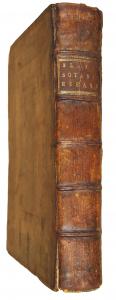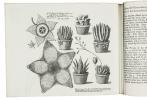Botanick Essays. In two parts. The first containing, The Structure of the Flowers, and the Fructification of Plants, with their various Distributions into Method: And the second, The Generation of Plants, with their Sexes and manner of impregnating the Seed: Also concerning the Animalcula in Semine Masculino. Together with: The Nourishment of Plants, and Circulation of the Sap in all Seasons, analogous to that of the Blood in Animals. With many curious remarks, and several discoveries and improvements.
Eur 1,500 / USD 1,700
The price shown on each item does not include V.A.T (Value Added Tax). As a result of the recent EU legislation we are required to charge our EU customers the percentage of V.A.T. charged by the customer’s country of residence, unless they possess a V.A.T. registration number. Postage Additional.
London, William and John Innys, printers to the Royal Society, 1720. 8vo (193 x 120mm). pp. (36), 414, (2, advertisements), with 5 (3 folded) engraved plates. Contemporary calf, hinges cracked but firm, spine with red gilt lettered label.
Blair expounded the then new view as to the sexual characters of plants
Important work dealing with plant physiology and dedicated to Isaac Newton. "Other botanical works, published in this country between 1700 and 1800 dealing with plant physiology, include the following: Botanick essays (1720). in which the author Patrick Blair, considered the structure of flowers, the fruit, different methods of classification, the generation of plants, and plant nutrition... Pulteney considered that the publication of 'Botanick essays' in which Blair expounded the then new view as to the sexual characters of plants, contributed greatly to the extension of the knowledge and the confirmation of the truth of this matter in England... Blair dealt in his book with the structure of plants, the methods of classification, the nourishment of plants, and the circulation of sap" (Henry II, pp. 40, 48, 49). Our copy has one more plate than quoted in the bibliographies.
B.M. (Nat. Hist.) I, 170.





